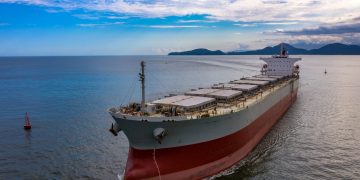The concept of “intelligent port” has emerged in the last decade, with many ports deploying Internet of Things (IoT), cloud-computing technologies, geographic information systems and computer simulation technologies, to optimise various aspects of port operations and enhance production efficiency.
“Intelligent port” has been described as a new type of port with fully integrated transportation system supported by innovative application of advanced technologies based on cyber-physical system as its structural framework. Unlike traditional ports, the intelligent port is capable of offering intelligent services including intelligent governance, intelligent business transaction, intelligent management and autonomous loading and unloading.
Key characteristics of an intelligent port In their recently-published ISCD report, The Baltic Exchange and Xinhua cite the key characteristics of an intelligent port:
Key technologies of an intelligent port
- IoT Technology: Typical IoT application in the ports include: Electronic tags for containers, port equipment operation status monitoring, engineering equipment asset management and intelligent energy management system.
- Big data technology: In the port industrial sector, the use of statistical analysis and forecast, and data-mining to scrutinise the huge amount of import/export data will help develop business opportunities for the port and business decision-making of related parties such as the shipping companies and shippers. It can also help fight smuggling and enhance inspection activities.
- Artificial Intelligence Technology: Artificial intelligence may find wide applications in port operation systems such as intelligent port equipment scheduling, intelligent site planning and intelligent berth planning.
- Automated port handling equipment: Advanced sensors, automatic positioning, machine vision, remote control, equipment intelligent diagnosis and assessment can be installed in large-scale port-side loading and unloading installations to implement unmanned or autonomous loading and unloading operations.
Examples of intelligent ports
- In August 2017, the Maritime and Port Authority Of Singapore (MPA) announced that it has achieved initial results with its port data analysis system. The system consists of seven modules including automatic monitoring of vessel movements within the port, refueling analysis, vessel arrival forecasting, berth utilisation monitoring and forecasting, pilot boarding and monitoring, and prohibited area monitoring. Three modules have been completed in September 2017, and the remaining four modules will be completed in January 2018.
MPA Singapore has received the GREEN4SEA Port Award 2018, for focusing on ‘Intelligent Port’ as a key area for port development, along with ‘Safe and Secure Port’, ‘Efficient Port’, and ‘Clean and Sustainable Port’.
- The Port of Rotterdam made port shipping more efficient by developing digital twin as well as hydrological & weather forecasting with the help of IBM’s IoT and cloud computing technologies. It also established a 3D printing laboratory to manufacture ship parts at much lower costs and in real time. The Rotterdam Port is planning to transform itself into the world’s most intelligent port by 2025.
- In December 2017, the world’s largest intelligent terminal – Shanghai Yangshan Automatic Deep-Water Port Phase IV – began its trial operations in Shanghai Port. Compared to manual labour, it has significantly improvement in balanced and sustained operation.
- In May 2018, Tianjin Port Group completed the switchover to an integrated system for its six container terminals. The integrated system replaced multiple heterogeneous systems used previously by the six terminals. After the switchover, shippers are able to complete relevant business transactions remotely, without visiting the port.
- By 2020, Dubai will increase the technology content of its port operation and introduce shipping systems and technologies such as data processing capability, cargo monitoring, information transmission and terminal management functions. It will strive to be both a “cargo port, as well as a “logistics information port”.
According to the report, the transformation and upgrading from traditional ports to intelligent ports include:
- Standardised, automated and intelligent operations: Introduce standardised workflows and interfaces, and support it with automated processes and intelligent operations to enhance the port’s efficiency and exploit the core advantages of an intelligent port;
- Hinterland logistics transportation: Strengthen route network of hinterland transportation and build Internet-based information platform to provide integrated port services for all parties of the logistics chain with the aim to reduce port operation costs;
- Co-development of intelligent port and intelligent city: A port can have significant influence on the economic development and environmental protection aspect of its host city – accelerated implementation of energy-saving and emission reduction policies to encourage innovation in new infrastructure and other measures that help optimize port environment.
In addition, the establishment of an intelligent port should be based on the strategic objective of a “3E”-level port: that is, there should be excellent port operation (Excel), extended openness in eco-environment construction (Extend), and sustainable exploratory development in innovative business (Explore).
A “3E”-level port will greatly enhance a port’s business environment through five means:
- Intellectualised operation of terminals,
- Collaboration of marine logistics,
- Facilitation of international trades,
- Popularisation of financial scenarios and
- Innovation of data services.

































































